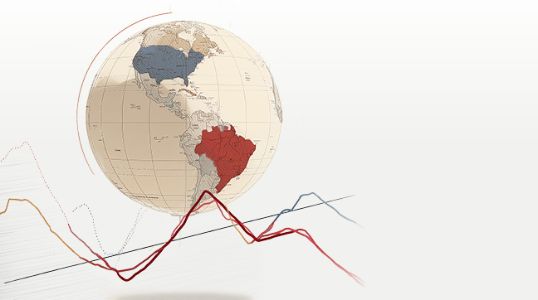Outlook 2026
Our top 10 themes for the year ahead
As we frame our outlook for 2026, it is clear that several new and rapidly evolving challenges are emerging alongside long-standing themes that have shaped the global landscape in recent years. Here we provide an in-depth review across three critical areas: Global economic and policy trends, Innovation and change, and Market opportunities.
Download EFG’s Outlook 2026 publication
Outlook 2026
How we did in 2025
Each year we review the predictions made in the previous year.
Overall score* for our 2025 predictions:
8/10
The three headwinds we saw to global growth – continued problems in China (the housing market, high private and public debt levels); high government debt and deficits in many advanced economies; and trade disruption were clearly evident. But growth in the main advanced economies was only slightly lower than in 2024 (1.6% compared with 1.8%); and the emerging economies grew at a similar rate to the previous year (4.2% compared to 4.3%).1
Membership of the BRICS expanded, with Indonesia becoming the tenth member of the group in January 2025. This came after the 2024 additions of Egypt, Ethiopia, Iran, and the UAE. These 10 economies represent almost half of the world’s population. Because of their generally faster rate of growth, they accounted for more than half of the world’s GDP growth in 2025. Ten ‘partner countries’ also joined the group in 2025. In addition, Emerging market equities significantly outperformed developed markets in 2025.
Seven central banks (Australia, UK, US, Turkey, Canada, Mexico and Indonesia) cut interest rates as the employment situation showed signs of deterioration, even though underlying inflation remained sticky.
Concern about fiscal trends was seen in most advanced economies, notably France, the UK and the US. In the US, however, there was some optimism that high deficits could be tackled by faster growth and increased tariff revenue. IMF forecasts see budget deficits in France and the UK persisting – with a consequent rise in their debt stocks – in the coming five years.2
The number of weekly active users of ChatGPT more than doubled in 2025: from around 300m to 800m. Other AI assistants also saw increased use. For businesses, AI assistance has become more widespread. Use is not confined to big companies. A survey of US small businesses found that 40% use AI in the workplace. 3 It is clear that China is also making great progress in the use of AI.
In the US, four Executive orders set out plans to increase US nuclear power capacity from 100GW to 400GW by 2050. China, meanwhile, plans to add 100GW of capacity (the same as the US’s current capacity) and surpass US capacity by 2030. Development of Small Modular Reactors (SMRs) has progressed quickly although how soon they can come online remains an issue. The need to add more nuclear electricity production is now widely recognised.
In the US, aggregate corporate earnings per share were 11% higher in the first ten months of 2025 than in the equivalent period of 2024. Earnings growth was stronger in the US than the rest of the world: world corporate earnings were 6% higher than a year earlier.4 Company earnings proved resilient in the face of the global uncertainties, particularly the impact of tariffs.
Total returns from the largest US technology-related equities (the ‘Magnificent 7’) were 25.4% in the year to 31 October, higher than the 14.5% returns from the other 493 stocks in the S&P500 index during the same period. The result was an overall total return from the S&P500 index of 17.5%. Although that meant the largest tech stocks continued to produce higher returns (as they had done in 2024), they were much more volatile in their price return than the other 493 stocks.
The consumer discretionary sector produced total returns of 7.8% in the year to 31 October 2025. That meant it ranked 6th of the 11 S&P500 sectors in the period. The main reasons for the relative weakness were disappointment about the slow pace of interest rate reductions and the uncertainty created by US tariff announcements and the impact on consumer sentiment.5
The US yield curve steepness (measured as the difference between 10-year yields and 3 month interest rates) was little changed during the year, with both falling by similar amounts. However, other parts of the curve did steepen - notably the 30 year-10 year spread and the 10 year-2 year spread. In the UK, France and Japan, yield curves steepened.
* Scoring as at 31 October 2025.
1 Source: IMF World Economic Outlook; October 2025.
2 Source: IMF World Economic Outlook; October 2025.
3 https://www.uschamber.com/assets/documents/ Impact-of-Technology-on-Small-Business-Report-2024.pdf
4 Source: Datastream Total Market Indices via LSEG; data are totals for the year to 31 October compared with the equivalent period of 2024.
5 Source: LSEG data for the year to 31 October 2025.
Discover more
From how we do business, to how we can help give you the future you deserve, find out more about EFG












